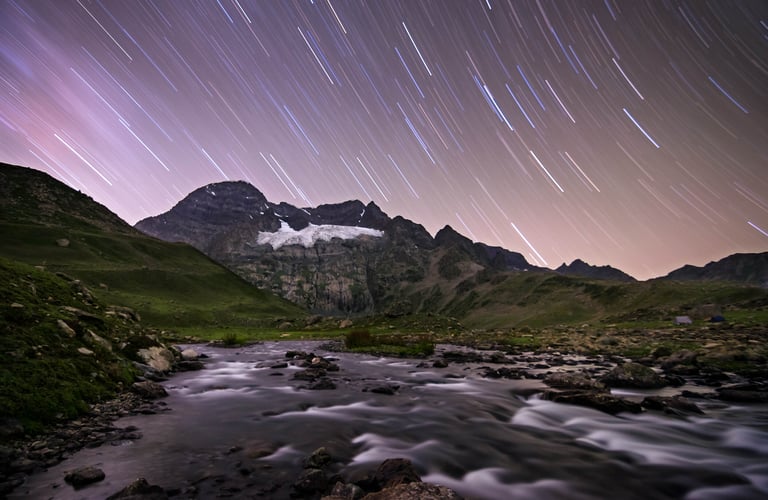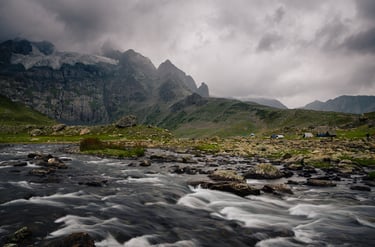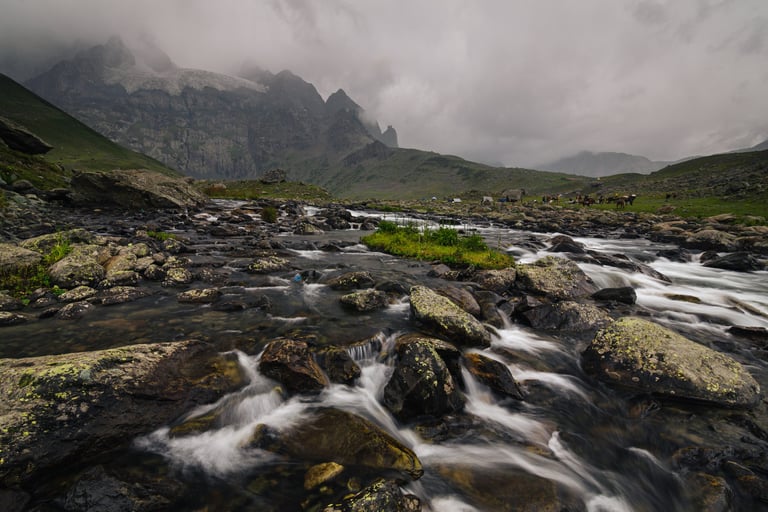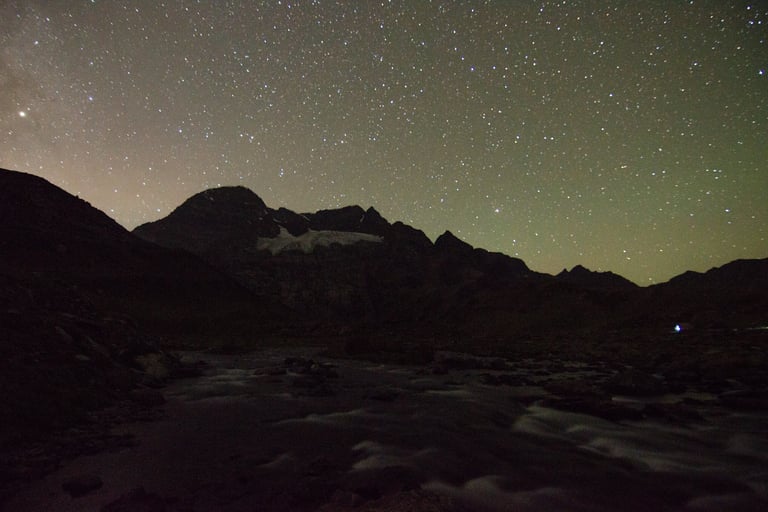Harmukh under the stars: A Landscape photography story
There are times when a photograph emerges in front of your eyes with the perfect light, easy to compose, compelling moment. You need to be ready with your camera to press the shutter. And more importantly, do not forget to remove the lens cap. Trust me, I have been there. But most of the time, it takes more than just a camera to make photographs. Join me as I take you behind the scenes of when I captured one of my early photographs.
5/8/20244 min read


Picture this. You are about 3551 meters above sea level, far from civilization, and surrounded by Himalayan Mountain ranges. You are at the bank of a river stream that originates from a high-altitude glacier lake a couple of hundred meters ahead of you. It is 10 o’clock at night. Your friends and the trekking team you are part of, have finished dinner and gone to bed after a long day’s trek. Vast darkness surrounds the land around, the only sound you can hear is of the flowing river and the only thing you can see are the stars, thousands of them span across the sky. Yes, this was one of those blissful moments of my life and I’m glad I had taken this picture as a souvenir from that place.


The place I am describing was the last campsite of a trek organized by a company called India Hikes. It is situated near Gangabal Lake, one of many high-altitude glacier lakes in Kashmir. If there is one place on earth, I would like to visit again, and again, and again, you see where I am going with this, it would be Kashmir. It has been so long since my visit, yet I can close my eyes and feel the heavenly breeze of Dal Lake flowing over me and suddenly I’m too busy daydreaming and trying to re-live the morning Shikara ride on Dal Lake. There is so much to like about Kashmir. The vast landscape with gorgeous Himalayan ranges and high-altitude lakes. The people. They are humble and welcoming and ridiculously good-looking. I always jokingly say that it is very easy to spot the tourists from the locals, you just find the ones that are not so good-looking. And the food! Oh my God, I am yet to have kababs as good as the ones I had there. And trust me, I have had a lot of them. Somebody rightly said, “if there is paradise on this earth somewhere, here it is”.
We reached the campsite well before sunset. This gave me plenty of time to scout the location around a find a composition of my liking. I wanted to capture the river and the mountain in the same frame. The cloudy-covered gloomy day resulted in the photos being rather one-dimensional in terms of color and light. I did not want that in this particular instant. The composition was not quite balanced and did not have any strong foreground interest. I tried to find interesting patterns in the river stream.


This frame had a foreground interest but was a bit too much as compared to the background. I thought a star trail might work to balance the elements for this foreground. All I needed was the clouds to get cleared. The location being far from the locality and at higher altitudes, we had much less light pollution. Which is ideal for photographing stars. Luckily, the cloud cover cleared after sundown and I went back to the location.




f/2.8, 11 mm, ISO 500, 1930 sec, long exposure noise reduction turned on
It is one thing to take photographs during the daytime and very different to try and find compositions in pitch-black darkness. Your tiny headlamp could only do so much to light up an entire mountain and the valley in front of you to compose a photograph. I could not see a thing. So I put my camera to work. I fixed my lens at the shortest focal length, and widest aperture and kept taking 30-sec test exposures to check the composition and fine-tune for the next shot. After a couple of trials, I found a balanced frame. I still had the water stream in the foreground and Harmukh at the back, but given the circumstances, I had to give up looking for more interesting foreground formations.
Another issue you are dealing with while photographing stars is that you have very little light to work with. It’s preferred to use wide-aperture lenses. Along with that, you increase your sensor ISO sensitivity to record the faintest lights. I was using a Tokina wide-angle lens for this shot which allowed me to open the aperture to f/2.8. This lens is a very good budget-friendly option for APSC sensors. My camera, on the other hand, the D5100, has its limitations. The dynamic range this camera can capture is about 7ev stops at iso 800. At 800 or above, the camera performs poorly and introduces grains and color noises into the photographs as evident from the photograph above. It is always preferred to use a full-frame or larger sensor camera for capturing stars as they are capable of capturing a greater dynamic range. For example, Nikon’s latest full-frame mirrorless Z7 camera has a dynamic range of 9ev stops at 800 ISO settings. On top of that, their image-rendering algorithms are much more sophisticated to deal with grains and color noise. To reduce the noise on my entry-level D5100, I did a couple of things. One: I reduced the ISO setting to 500, this gave me an 8ev dynamic range. Two: I turned on in-camera long exposure noise reduction. So the camera took another exposure of the same exposure time but closed the shutter to capture electronic noise. Then it removes the noise signal from the actual exposure. After making these two adjustments, I set an exposure of about half an hour. I was quite satisfied with the results. A little tweak in Lightroom and a selective noise reduction routine in Photoshop gave me the final result I liked.
